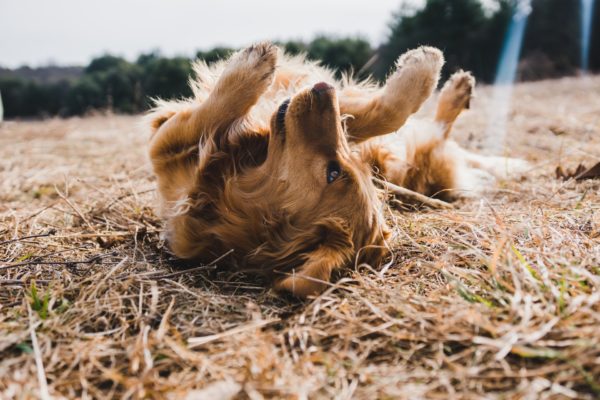Considering their microscopic size, fleas can create huge problems for your dog and household. Fleas are the most common external parasite of pets, and they thrive by drinking your dog’s blood and multiplying fast. What should you do if your dog gets fleas and how can you prevent a flea infestation in the first place? Here’s what pet parents need to know about fleas on dogs.
Table of contents
- What are fleas?
- How do you know if your dog has fleas?
- How can ElleVet’s CBD + CBDA help itchy dogs?
- How do dogs get fleas?
- Where are fleas found?
- How to get rid of fleas on your dog
- Treating fleas in your environment
- How can you prevent fleas?
- Take home message on fleas
What are fleas?
Fleas are small insects—considered parasites—that survive by feeding on animal or human blood. Adult fleas are about 1/8 of an inch long and their eggs, the size of dust particles, can barely be seen with the naked eye. Fleas are dark reddish-brown in color and have biting mouth parts. They can be very hard to spot because they move so fast along the animal’s body.
Flea bites can cause discomfort, itchiness, and irritation. Many dogs are allergic to flea saliva and can get extremely itchy after even just one bite. Excessive itching is not only unpleasant for your dog but can cause much more serious issues like hot spots and infections.
In addition to causing itching and other skin problems, fleas can transmit diseases and cause anemia. In heavy infestations, especially in young or unhealthy dogs, the blood loss caused by fleas can be significant. A single female flea can consume up to 15 times her body weight in blood over the several weeks of her adult life. In addition, fleas can carry several diseases, including plague
Unfortunately, fleas also act as hosts for another unwanted parasite: tapeworms. Dogs ingest fleas while biting at an itchy spot or grooming themselves or another dog. When a dog eats a flea containing tapeworm eggs, the eggs move into your dog’s small intestines, where they hatch and mature into adults.
How do you know if your dog has fleas?
These little parasites can be tricky to spot, but some of the signs that your dog has fleas are obvious. If your dog is suffering from fleas, you may notice:
- Severe itching, particularly in the rear areas of your dog’s body where the coat is thick and your pup cannot easily reach. Your dog may bite and chew their skin in addition to pawing at itchy areas. Fleas like to infest the neck, ears, lower back, abdomen, and base of the tail in dogs.
- Skin irritation and hair loss is common if your dog has been scratching for a while. Fleas leave tiny, red, raised dots on your dog’s skin. They are typically smaller than other insect bites, although they can become inflamed after a dog scratches. Some dogs have a stronger reaction to flea bites than others, which creates a much larger red area. Look for red bumps on your pet’s groin, belly, under the legs, or at the base of their tail. Leaving fleas untreated can lead to lesions, scabs, infection, and hair loss in infested and itchy areas.
- Visible fleas in your dog’s coat may be seen while combing your dog with a flea comb. These tiny parasites measure approximately 1-to-3 millimeters in length, but their dark brown or black bodies are relatively easy to see moving around, especially on light colored dog hair or skin.
- Black flecks, or “flea dirt,” in your dog’s coat, can be a tell-tale sign that your dog has fleas. These tiny flecks are flea droppings and will be present on your dog’s skin and coat if they are suffering an infestation. These specks are actually dried blood, and if you place them on a damp paper towel they will turn from black to brown and then to red as the blood rehydrates.
How can ElleVet’s CBD + CBDA help itchy dogs?
Incessant scratching is miserable for pups and difficult for pet parents to watch. Fortunately, while ElleVet’s CBD + CBDA can’t get rid of your dog’s fleas, it is proven effective in providing dogs support for itchy skin by working to improve discomfort and reduce inflammation.
ElleVet conducted a groundbreaking study in 2020 investigating the efficacy of our CBD + CBDA on dogs with Pruritus, or itchy skin. Results showed that over 65% of dogs enrolled in the study, who had not responded to other commonly used products, had a significant improvement in skin itchiness after using ElleVet’s CBD + CBDA. By modulating dogs’ inflammatory response and perception of discomfort, CBD + CBDA can help eliminate their urge to scratch.
How can my dog get fleas?
Dogs often get infested with fleas through contact with other animals or contact with fleas in the environment. While fleas can’t fly, they are skilled jumpers.
Adult fleas live, feed, and mate on our pets. Female fleas lay eggs that then fall off the host into the environment, where they hatch into larvae. The larvae eat organic debris until they mature into pupae. The pupae may lie dormant for weeks to months, awaiting the ideal environmental conditions before hatching into adults. Newly hatched adult fleas use their strong back legs to jump onto a host animal to complete their life cycle. Two days after eating a blood meal from the host, the female flea begins to lay eggs and the life cycle repeats.
Where are fleas found?
Fleas love warm, humid environments with lots of shade and places to hide. Wooded areas with long grass or homes with carpets and central heating are ideal flea conditions. Homes with flea infestations will typically have fleas that have migrated deep down in carpets, furniture, or cracks in the floors away from light.
Colder climates have shorter peak flea seasons or may not have flea problems at all. For example, dry, desert regions like those found in parts of Colorado, Arizona, and New Mexico have lower risk of flea infestations. Fleas are a year-round threat to pets in southeastern states like Florida, Alabama, and Louisiana.
How to get rid of fleas on your dog
If your dog is suffering from fleas, you should call your veterinarian as soon as possible. The itchy skin that comes with flea infestations is very uncomfortable for dogs, and your vet will provide guidance on exterminating the pests, reducing itchy skin, and preventing future flea infestations.
There are many different options for flea control and treatment. Shampoos, sprays, powders, and topical or oral products are all available. Some only target adults, while others target flea eggs, larvae, and adult fleas. With this, it is important to use the right one and repeat multiple applications or treatments, if necessary, in order to exterminate all fleas.
Flea control products are available both over the counter and by prescription. Highly effective prescription treatments like Bravecto begin killing fleas within two hours!
While you are treating flea infestations on your dog and in your living space, discourage your dog from getting on furniture or rolling around in the backyard. Households with multiple pets should closely inspect all pets—if one dog has fleas, there’s a very good chance that all dogs have fleas.
Treating fleas in your environment
As you are treating your dog for fleas, you should also be concerned with the fleas in various life stages scattered throughout your house and yard. Fleas can also live up to six months without feeding on a host, so thoroughly cleaning your environment is very important.
There are a number of products are available to kill the adult and larval stages of fleas and stop the flea life cycle, such as:
- Adulticide sprays for use in the house
- Sprays containing insect growth regulators (IGRs) for use in the house
- Insecticides applied by professional pest control companies
It is important to note that flea infestation treatment products address the egg, larval, and adult stages of the flea lifecycle, but no insecticide kills them at the cocoon (pupal) stage. With this, it is crucial to continue treatment throughout the fleas’ 21-day lifecycle.
Household sprays should be used in places where the flea eggs, larvae, and pupae are likely to be, such as carpets, beds, and other furniture. For more serious infestations, treat the entire household first and then concentrate on these hot spots. Be sure to move cushions and furniture to spray underneath them, as larvae can also live in baseboards and the cracks and crevices between floor seams or floorboards.
Flea eggs and pupae are extremely tough and resistant to the effects of insecticides. To remove eggs, as well as dead fleas, your pet’s bedding should be washed in hot water or replaced entirely. Regular and thorough vacuuming of your carpets, floors, and soft furnishings can remove a large number of flea eggs, larvae, and pupae. You will need to throw away the vacuum bag to prevent eggs and larvae from developing inside the vacuum cleaner. Vacuuming prior to the application of a spray is helpful because the vibrations will encourage newly developed fleas to emerge from pupae, which will then be killed by the insecticide.
How can you prevent fleas?
With the right products and strategies, fleas are easily preventable in dogs. Here are some tips for keeping your pets and home flea-free:
- Keep your lawn cut short
- Vacuum regularly
- Limit the amount of time your dog spends outdoors
- Limit contact with wild and stray animals
- Groom your dog regularly—baths and brushing keep your dog clean and also allow you to check for fleas and other skin irritations
- Year-round preventatives are available both over the counter and with a veterinarian’s prescription and come in oral medications and topical products. Ask your veterinarian about products like Simparica and Nexgard.
Take home message on fleas
Fleas are the most common external parasite of pets. They drink your dog’s blood and multiply fast, creating a big problem in a small amount of time. In addition to causing itching and other skin problems, fleas can transmit diseases and cause anemia. Year-round prevention is the best way to ensure your dog—and household—don’t get these itchy pests.









